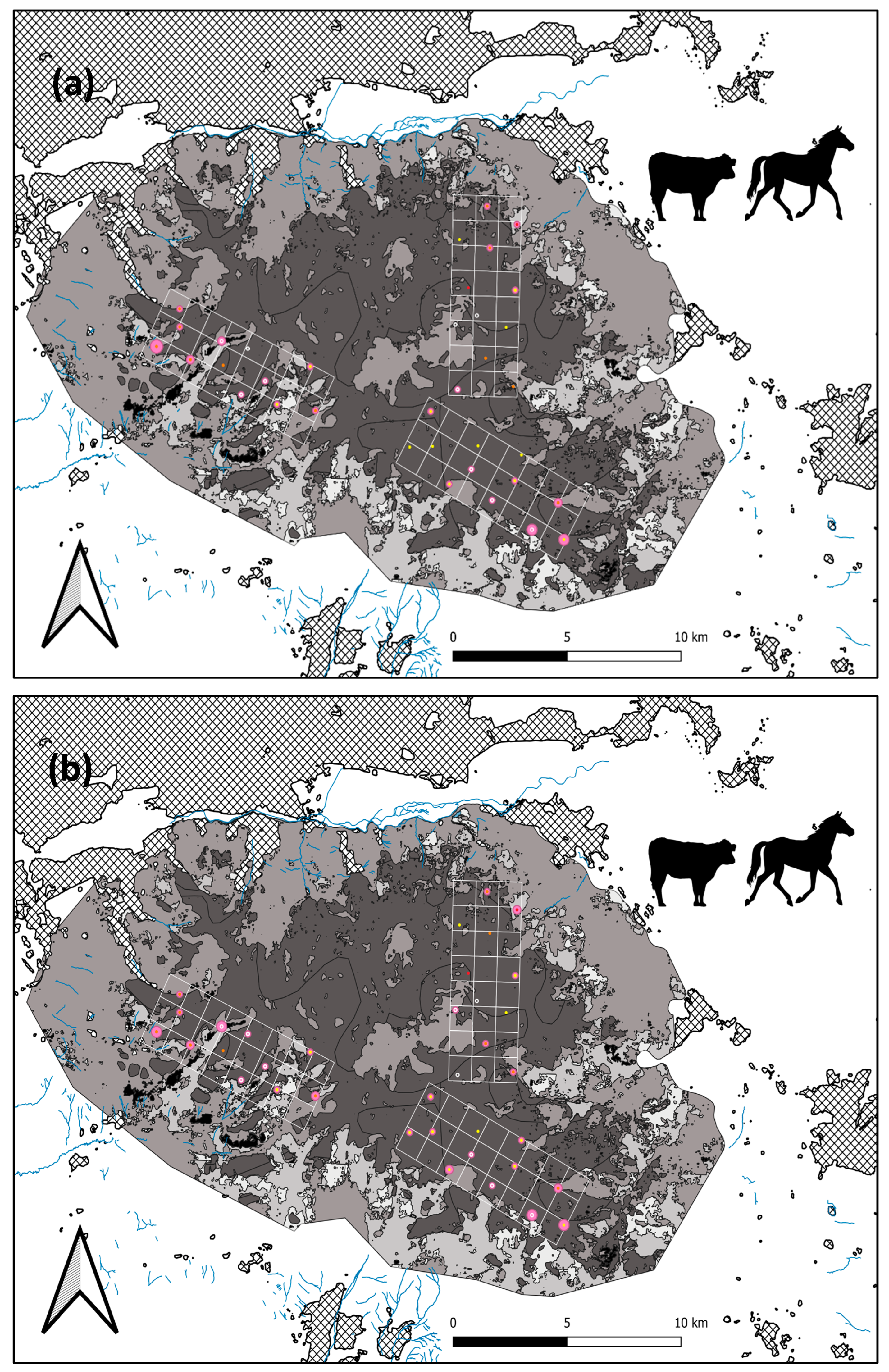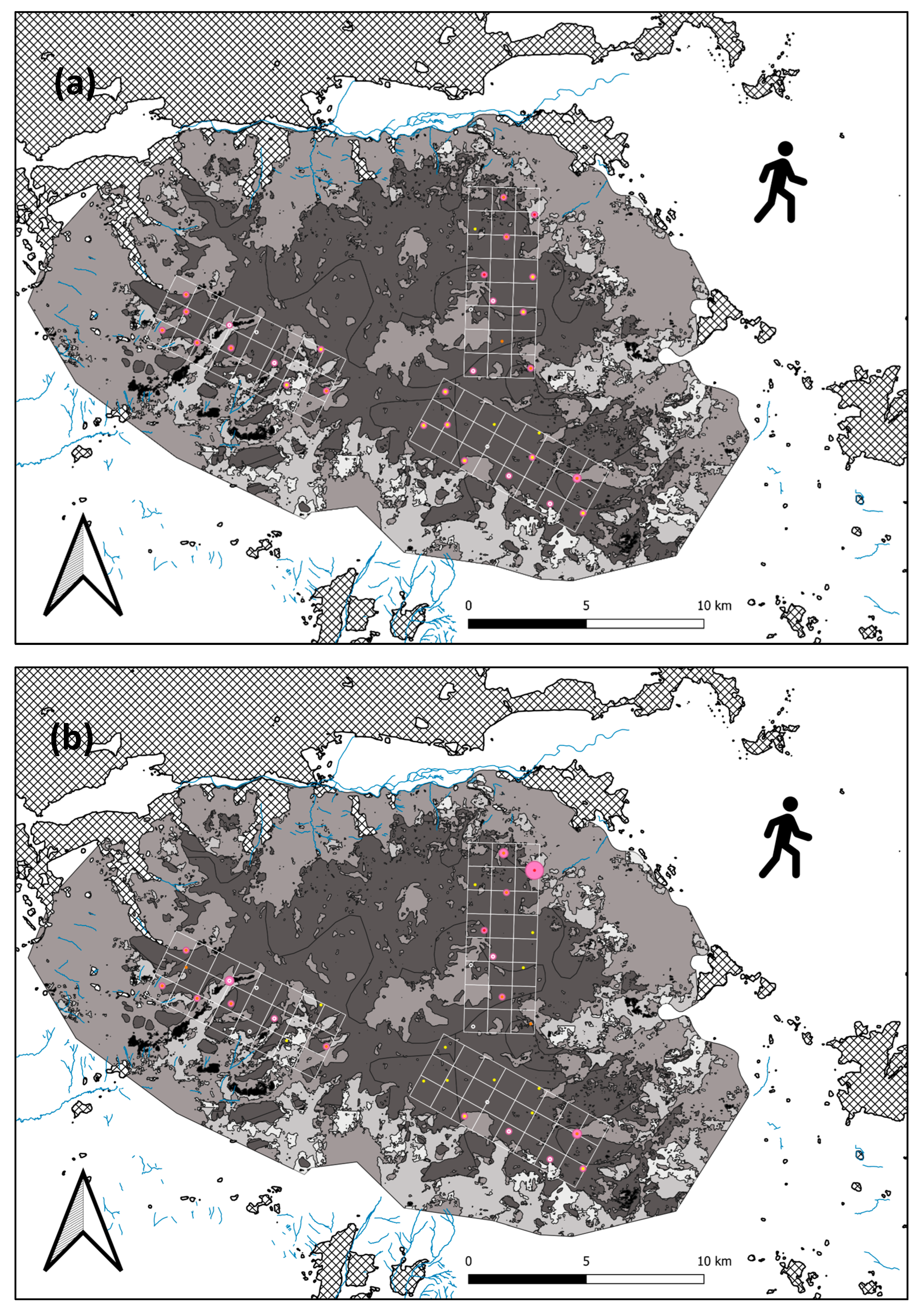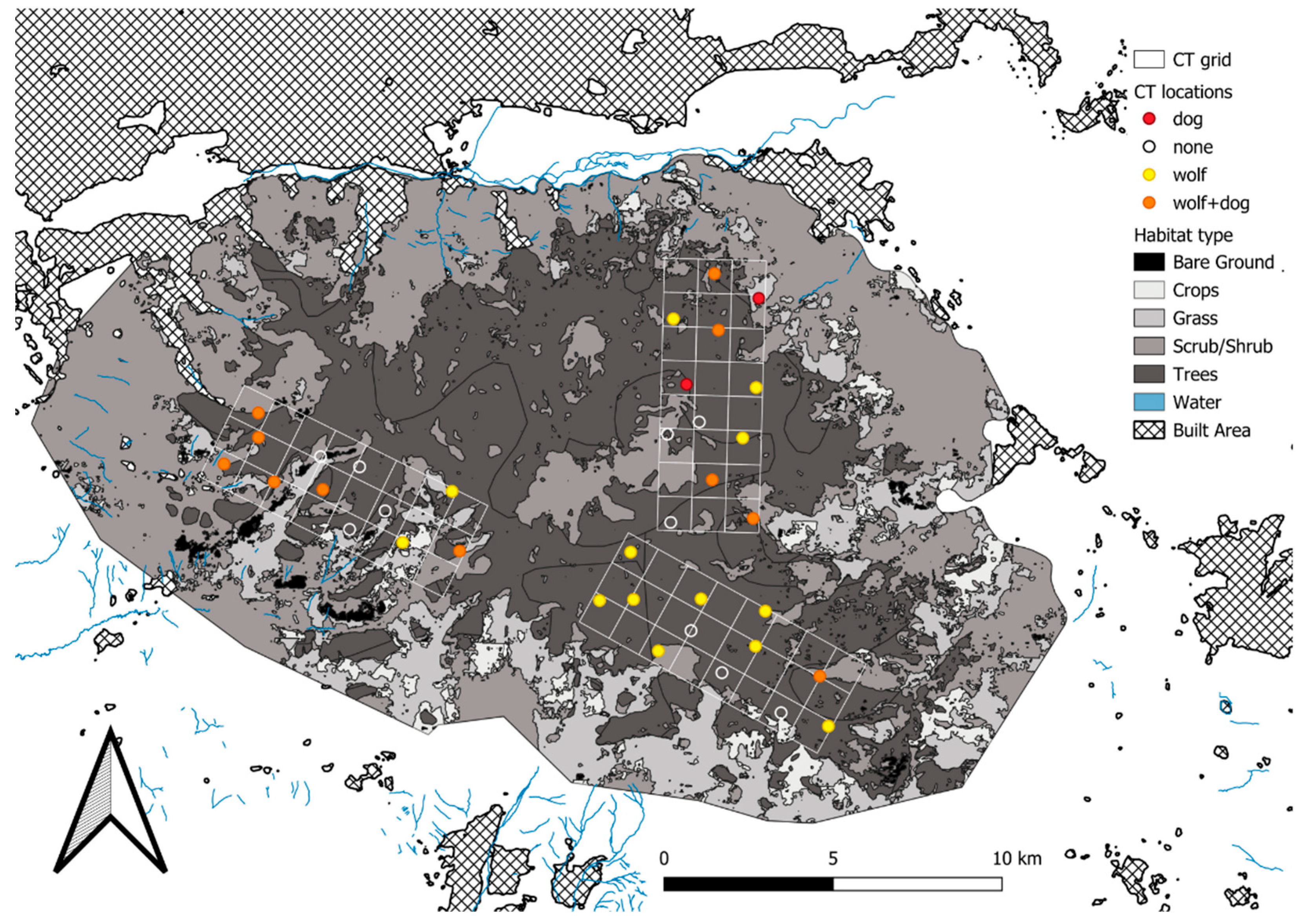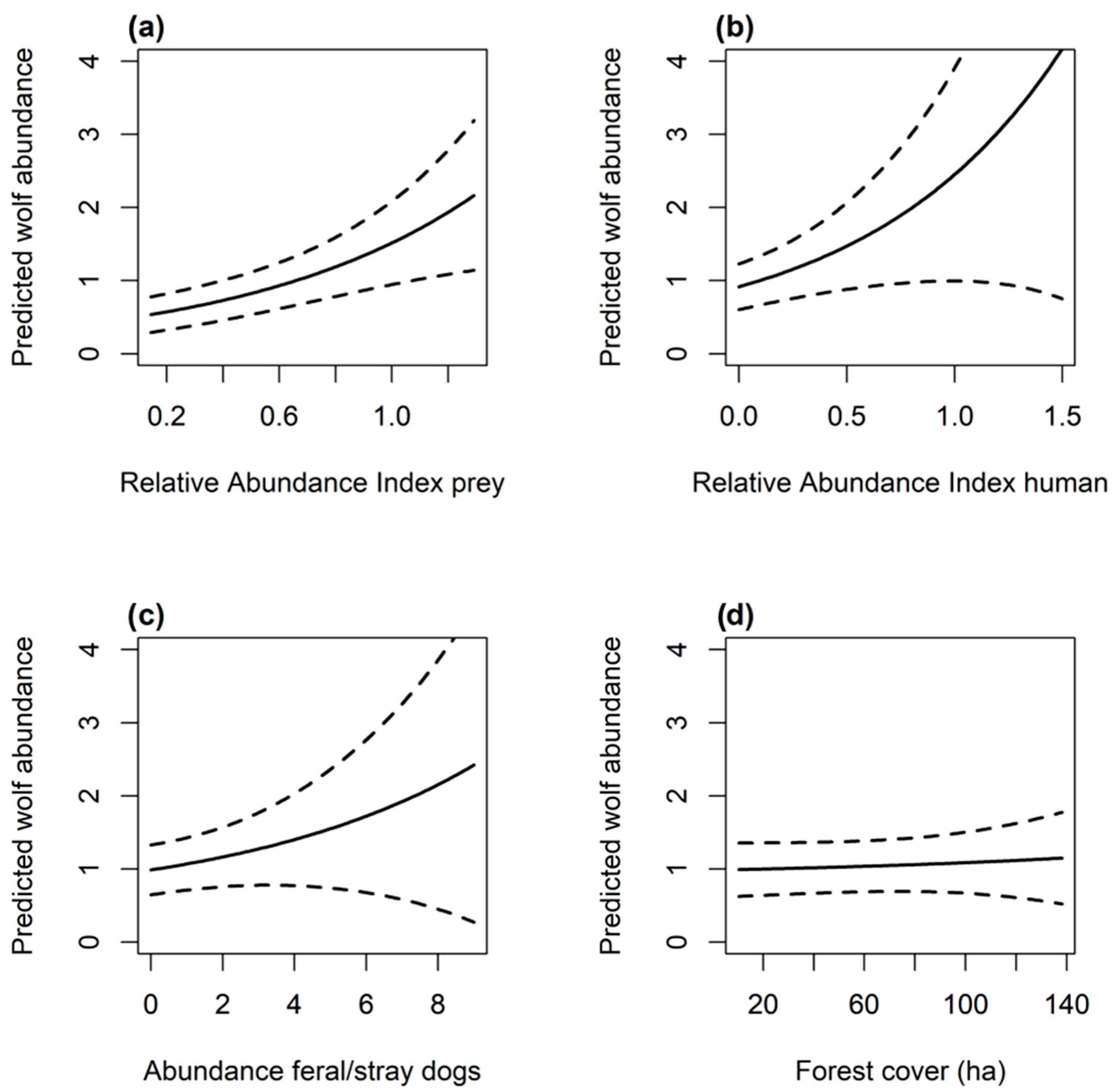Urban Edge Predators: Wolf Spatial and Temporal Ecology at the Wildland–Urban Interface in Mongolia
Abstract
Simple Summary
Abstract
1. Introduction
2. Materials and Methods
2.1. Study Area
2.2. Camera Trap Design
2.3. Activity
2.4. Abundance Index
3. Results
4. Discussion
5. Conclusions
Author Contributions
Funding
Institutional Review Board Statement
Data Availability Statement
Acknowledgments
Conflicts of Interest
Appendix A
| Model# | Abundance Formula | AIC | ∆ AIC | AIC Weight | Cumulative Weight |
|---|---|---|---|---|---|
| model19 | year + dog + RAI_Prey + RAI_Human | 434.65 | 0 | 0.16 | 0.16 |
| model40 | year + RAI_Prey + RAI_Human | 435.47 | 0.81 | 0.10 | 0.26 |
| model10 | year + forest + RAI_Prey + RAI_Human | 436.55 | 1.89 | 0.06 | 0.32 |
| model36 | year + dog + RAI_Prey | 436.58 | 1.92 | 0.06 | 0.38 |
| model16 | year + dist_urban + RAI_Prey + RAI_Human | 436.81 | 2.16 | 0.05 | 0.44 |
| model13 | year + dist_urban + dog + RAI_Human | 437.09 | 2.43 | 0.05 | 0.48 |
| model12 | year + dist_urban + dog + RAI_Prey | 437.45 | 2.8 | 0.04 | 0.52 |
| model6 | year + forest + dog + RAI_Prey | 437.72 | 3.07 | 0.03 | 0.56 |
| model7 | year + forest + dog + RAI_Human | 437.92 | 3.26 | 0.03 | 0.59 |
| model37 | year + dog + RAI_Human | 437.95 | 3.3 | 0.03 | 0.62 |
| model17 | year + dog + RAI_Livestock + RAI_Prey | 438.15 | 3.49 | 0.03 | 0.64 |
| model25 | year + dog | 438.21 | 3.56 | 0.03 | 0.67 |
| model39 | year + RAI_Livestock + RAI_Human | 438.27 | 3.61 | 0.03 | 0.7 |
| model24 | year + RAI_Human | 438.38 | 3.72 | 0.02 | 0.72 |
| model23 | year + RAI_Prey | 438.41 | 3.76 | 0.02 | 0.75 |
| model9 | year + forest + RAI_Livestock + RAI_Human | 438.53 | 3.88 | 0.02 | 0.77 |
| model38 | year + RAI_Livestock + RAI_Prey | 438.79 | 4.14 | 0.02 | 0.79 |
| model22 | year + RAI_Livestock | 439.1 | 4.44 | 0.02 | 0.81 |
| model18 | year + dog + RAI_Livestock + RAI_Human | 439.12 | 4.47 | 0.02 | 0.82 |
| model31 | year + dist_urban + dog | 439.19 | 4.53 | 0.02 | 0.84 |
| model27 | year + forest + dog | 439.42 | 4.77 | 0.01 | 0.85 |
| model35 | year + dog + RAI_Livestock | 439.53 | 4.88 | 0.01 | 0.87 |
| model15 | year + dist_urban + RAI_Livestock + RAI_Human | 439.62 | 4.97 | 0.01 | 0.88 |
| model30 | year + forest + RAI_Human | 439.8 | 5.15 | 0.01 | 0.89 |
| model34 | year + dist_urban + RAI_Human | 439.81 | 5.15 | 0.01 | 0.9 |
| model5 | year + forest + dog + RAI_Livestock | 440.17 | 5.52 | 0.01 | 0.91 |
| model29 | year + forest + RAI_Prey | 440.38 | 5.72 | 0.01 | 0.92 |
| model33 | year + dist_urban + RAI_Prey | 440.41 | 5.75 | 0.01 | 0.93 |
| model8 | year + forest + RAI_Livestock + RAI_Prey | 440.47 | 5.82 | 0.01 | 0.94 |
| model28 | year + forest + RAI_Livestock | 440.62 | 5.96 | 0.01 | 0.95 |
| model11 | year + dist_urban + dog + RAI_Livestock | 440.66 | 6 | 0.01 | 0.96 |
| model14 | year + dist_urban + RAI_Livestock + RAI_Prey | 440.79 | 6.14 | 0.01 | 0.96 |
| model1 | year + forest + dist_urban + dog | 440.86 | 6.21 | 0.01 | 0.97 |
| model32 | year + dist_urban + RAI_Livestock | 441.07 | 6.42 | 0.01 | 0.98 |
| model21 | year + dist_urban | 441.56 | 6.91 | 0.01 | 0.99 |
| model20 | year + forest | 441.56 | 6.9 | 0.01 | 0.98 |
| model4 | year + forest + dist_urban + RAI_Human | 441.57 | 6.91 | 0.01 | 0.99 |
| model3 | year + forest + dist_urban + RAI_Prey | 442.35 | 7.69 | 0.00 | 1 |
| model2 | year + forest + dist_urban + RAI_Livestock | 442.54 | 7.89 | 0.00 | 1 |
| model26 | year + forest + dist_urban | 443.55 | 8.9 | 0.00 | 1 |



References
- Davis, J.B. The Wildland-Urban Interface: Paradise or Battleground? J. For. 1990, 88, 26–31. [Google Scholar] [CrossRef]
- Carlson, A.R.; Helmers, D.P.; Hawbaker, T.J.; Mockrin, M.H.; Radeloff, V.C. The Wildland–Urban Interface in the United States Based on 125 Million Building Locations. Ecol. Appl. 2022, 32, e2597. [Google Scholar] [CrossRef]
- Kreling, S.E.S.; Gaynor, K.M.; Coon, C.A.C. Roadkill Distribution at the Wildland-Urban Interface. J. Wildl. Manag. 2019, 83, 1427–1436. [Google Scholar] [CrossRef]
- Olson, E.R.; Van Deelen, T.R.; Wydeven, A.P.; Ruid, D.B.; MacFarland, D.M.; Ventura, S.J. A Landscape of Overlapping Risks for Wolf-Human Conflict in Wisconsin, USA. J. Environ. Manag. 2019, 248, 109307. [Google Scholar] [CrossRef]
- Bar-Massada, A.; Radeloff, V.C.; Stewart, S.I. Biotic and Abiotic Effects of Human Settlements in the Wildland–Urban Interface. BioScience 2014, 64, 429–437. [Google Scholar] [CrossRef]
- Batsaikhan, A.; Jung, S.; Hachinger, S. The State of Online Citizen Science in Mongolia and Its Potential for Environmental Challenges. PLoS ONE 2023, 18, e0289924. [Google Scholar] [CrossRef]
- Regdel, D.; Dugarzhav, C.; Gunin, P.D. Ecological Demands on Socioeconomic Development of Mongolia under Climate Aridization. Arid Ecosyst. 2012, 2, 1–10. [Google Scholar] [CrossRef]
- National Statistics Office of Mongolia. Available online: https://en.nso.mn/home (accessed on 13 November 2024).
- Jargal, J. Protected Area Status in Mongolia. Mong. J. Biol. Sci. 2003, 1, 49–54. [Google Scholar] [CrossRef]
- Shar, S.; Samiya, R.; Gombobaatar Tseveenmyadag, N.; Tsagaantsooj, N.; Tungalag, R. The Common Fauna and Flora of the Bogdkhan Mountain; Soyombo Printing: Ulaanbaatar, Mongolia, 2008. [Google Scholar]
- Blašković, S.; Gomerčić, T.; Topličanec, I.; Sindičić, M. Temporal Overlap of Human and Apex Predator Activity on Wildlife Trails and Forest Roads. J. Vertebr. Biol. 2022, 71, 22029. [Google Scholar] [CrossRef]
- Enkhbat, E.; Bayanmunkh, U.-U.; Yunden, A.; Gansukh, S.; Yansanjav, A.; Koprowski, J.L.; Mazzamuto, M.V. Use of Drone Technology to Monitor and Map Endangered Marmot Populations in Mongolian Grasslands. Hystrix Ital. J. Mammal. 2023, 34, 62–67. [Google Scholar] [CrossRef]
- Adyasuren, T.; Shiirevdamba, T.; Darin, B. Ecosystems Atlas of Bogdkhan Mountain; ADMON Print: Ulaanbaatar, Mongolia, 1998; p. 40. [Google Scholar]
- Amarsaikhan, D.; Bat-Erdene, T.; Janzen, J.; Narantsetseg, C.; Ganzorig, M.; Nergui, B. Applications of Remote Sensing Techniques and GIS for Urban Land Change Studies in Mongolia. Am. J. Geogr. Inf. Syst. 2013, 2, 27–36. [Google Scholar]
- Mortelliti, A.; Brehm, A.M.; Evans, B.E. Umbrella Effect of Monitoring Protocols for Mammals in the Northeast US. Sci. Rep. 2022, 12, 1893. [Google Scholar] [CrossRef]
- Ivan, J.; Newkirk, E. CPW Photo Warehouse: A Custom Database to Facilitate Archiving, Identifying, Summarizing and Managing Photo Data Collected from Camera Traps. Methods Ecol. Evol. 2016, 7, 499–504. [Google Scholar] [CrossRef]
- Durán-Antonio, J.; González-Romero, A.; Sosa, V.J. Activity Overlap of Carnivores, Their Potential Wild Prey, and Temporal Segregation, with Livestock in a Biosphere Reserve in the Chihuahuan Desert. J. Mammal. 2020, 101, 1609–1621. [Google Scholar] [CrossRef]
- Ridout, M.S.; Linkie, M. Estimating Overlap of Daily Activity Patterns from Camera Trap Data. JABES 2009, 14, 322–337. [Google Scholar] [CrossRef]
- Frey, S.; Fisher, J.T.; Burton, A.C.; Volpe, J.P. Investigating Animal Activity Patterns and Temporal Niche Partitioning Using Camera-Trap Data: Challenges and Opportunities. Remote Sens. Ecol. Conserv. 2017, 3, 123–132. [Google Scholar] [CrossRef]
- Schmid, F.; Schmidt, A. Nonparametric Estimation of the Coefficient of Overlapping—Theory and Empirical Application. Comput. Stat. Data Anal. 2006, 50, 1583–1596. [Google Scholar] [CrossRef]
- Niedballa, J.; Sollmann, R.; Courtiol, A.; Wilting, A. camtrapR: An R Package for Efficient Camera Trap Data Management. Methods Ecol. Evol. 2016, 7, 1457–1462. [Google Scholar] [CrossRef]
- Tasdan, F.; Yeniay, Ö. Power Study of Circular Anova Test against Nonparametric Alternatives. Int. J. Appl. Math. Stat. 2014, 43, 97–115. [Google Scholar]
- MacKenzie, D.I.; Nichols, J.D.; Hines, J.E.; Knutson, M.G.; Franklin, A.B. Estimating Site Occupancy, Colonization, and Local Extinction When a Species Is Detected Imperfectly. Ecology 2003, 84, 2200–2207. [Google Scholar] [CrossRef]
- MacKenzie, D.I.; Bailey, L.L. Assessing the Fit of Site-Occupancy Models. JABES 2004, 9, 300–318. [Google Scholar] [CrossRef]
- Royle, J.A.; Dawson, D.K.; Bates, S. Modeling Abundance Effects in Distance Sampling. Ecology 2004, 85, 1591–1597. [Google Scholar] [CrossRef]
- Kéry, M.; Royale, A. Applied Hierarchical Modeling in Ecology: Analysis of Distribution, Abundance and Species Richness in R and BUGS; Academic Press: Cambridge, MA, USA, 2020; ISBN 978-0-12-809585-0. [Google Scholar]
- Moran, P.A.P. A Test for the Serial Independence of Residuals. Biometrika 1950, 37, 178–181. [Google Scholar] [CrossRef]
- Mazzamuto, M.V.; Enkhbat, E.; Dolphin, J.; Gankhuyag, G.; Munkhtsog, B.; Bayanmunkh, U.; Sodnompil, B.; Nasanbat, B.; Yansanjav, A.; Koprowski, J.L.; et al. Sustainable Livestock Management under Anthropogenic Pressure: Bridging Traditional Herding and Contemporary Conservation in Eurasia’s Oldest Protected Area. J. Environ. Manag. 2025, 379, 124901. [Google Scholar] [CrossRef] [PubMed]
- Young, J.K.; Olson, K.A.; Reading, R.P.; Amgalanbaatar, S.; Berger, J. Is Wildlife Going to the Dogs? Impacts of Feral and Free-Roaming Dogs on Wildlife Populations. BioScience 2011, 61, 125–132. [Google Scholar] [CrossRef]
- Gompper, M.E. The dog-human-wildlife interface: Assessing the scope of the problem. Free-Ranging Dogs Wildl. Conserv. 2014, 1, 9–54. [Google Scholar]
- Alatawi, A.S. Conservation of the Threatened Arabian Wolf (Canis lupus arabs) in a Mountainous Habitat in Northwestern Saudi Arabia. Biology 2025, 14, 839. [Google Scholar] [CrossRef]
- Vilà, C.; Urios, V.; Castroviejo, J. Observations on the daily activity patterns in the Iberian wolf BT. In Ecology and Conservation of Wolves in a Changing World; Canadian Circumpolar Institute: Edmonton, AB, Canada, 1995; pp. 335–340. [Google Scholar]
- Ciucci, P.; Boitani, L.; Francisci, F.; Andreoli, G. Home Range, Activity and Movements of a Wolf Pack in Central Italy. J. Zool. 1997, 243, 803–819. [Google Scholar] [CrossRef]
- Theuerkauf, J.; Jȩdrzejewski, W.; Schmidt, K.; Okarma, H.; Ruczyński, I.; Śniezko, S.; Gula, R. Daily Patterns and Duration of Wolf Activity in the Białowieza Forest, Poland. J. Mammal. 2003, 84, 243–253. [Google Scholar] [CrossRef]
- Kusak, J.; Skrbinšek, A.M.; Huber, D. Home Ranges, Movements, and Activity of Wolves (Canis lupus) in the Dalmatian Part of Dinarids, Croatia. Eur. J. Wildl. Res. 2005, 51, 254–262. [Google Scholar] [CrossRef]
- Chavez, A.S.; Gese, E.M. Landscape Use and Movements of Wolves in Relation to Livestock in a Wildland-Agriculture Matrix. J. Wildl. Manag. 2006, 70, 1079–1086. [Google Scholar] [CrossRef]
- Theuerkauf, J.; Gula, R.; Pirga, B.; Tsunoda, H.; Eggermann, J.; Brzezowska, B.; Rouys, S.; Radler, S. Human Impact on Wolf Activity in the Bieszczady Mountains, SE Poland. Ann. Zool. Fenn. 2007, 44, 225–231. [Google Scholar]
- Packard, J.M. 2. Wolf Behavior: Reproductive, Social, and Intelligent. In Wolves: Behavior, Ecology, and Conservation; Mech, L.D., Boitani, L., Eds.; University of Chicago Press: Chicago, IL, USA, 2010; pp. 35–65. ISBN 978-0-226-51698-1. [Google Scholar]
- Eggermann, J.; Gula, R.; Pirga, B.; Theuerkauf, J.; Tsunoda, H.; Brzezowska, B.; Rouys, S.; Radler, S. Daily and Seasonal Variation in Wolf Activity in the Bieszczady Mountains, SE Poland. Mamm. Biol. 2009, 74, 159–163. [Google Scholar] [CrossRef]
- Marucco, F. Spatial Population Dynamics of Recolonizing Wolves in the Western Alps. Ph.D. Thesis, University of Montana, Missoula, MT, USA, 2009. [Google Scholar]
- Rossa, M.; Lovari, S.; Ferretti, F. Spatiotemporal Patterns of Wolf, Mesocarnivores and Prey in a Mediterranean Area. Behav. Ecol. Sociobiol. 2021, 75, 32. [Google Scholar] [CrossRef]
- Tiralla, N.; Holzapfel, M.; Ansorge, H. Feeding Ecology of the Wolf (Canis lupus) in a near-Natural Ecosystem in Mongolia. Mamm. Biol. 2021, 101, 83–89. [Google Scholar] [CrossRef]
- Weckel, M.; Giuliano, W.; Silver, S. Jaguar (Panthera onca) Feeding Ecology: Distribution of Predator and Prey through Time and Space. J. Zool. 2006, 270, 25–30. [Google Scholar] [CrossRef]
- Arias-Del Razo, I.; Hernández, L.; Laundré, J.W.; Myers, O. Do Predator and Prey Foraging Activity Patterns Match? A Study of Coyotes (Canis latrans), and Lagomorphs (Lepus Californicus and Sylvilagus Audobonii). J. Arid. Environ. 2011, 75, 112–118. [Google Scholar] [CrossRef]
- Basille, M.; Fortin, D.; Dussault, C.; Ouellet, J.-P.; Courtois, R. Ecologically Based Definition of Seasons Clarifies Predator–Prey Interactions. Ecography 2013, 36, 220–229. [Google Scholar] [CrossRef]
- Courbin, N.; Fortin, D.; Dussault, C.; Fargeot, V.; Courtois, R. Multi-Trophic Resource Selection Function Enlightens the Behavioural Game between Wolves and Their Prey. J. Anim. Ecol. 2013, 82, 1062–1071. [Google Scholar] [CrossRef]
- Foster, V.C.; Sarmento, P.; Sollmann, R.; Tôrres, N.; Jácomo, A.T.A.; Negrões, N.; Fonseca, C.; Silveira, L. Jaguar and Puma Activity Patterns and Predator-Prey Interactions in Four Brazilian Biomes. Biotropica 2013, 45, 373–379. [Google Scholar] [CrossRef]
- Yang, H.; Zhao, X.; Han, B.; Wang, T.; Mou, P.; Ge, J.; Feng, L. Spatiotemporal Patterns of Amur Leopards in Northeast China: Influence of Tigers, Prey, and Humans. Mamm. Biol. 2018, 92, 120–128. [Google Scholar] [CrossRef]
- Nakazawa, C.; Tungalagtuya, K.; Maruyama, N.; Suda, K. Food Habits of Gray Wolves in the Bogdkhan Mountain Strictly Protected Area, Mongolia. Biosph. Conserv. Nat. Wildl. Hum. 2008, 9, 1–8. [Google Scholar] [CrossRef]
- On the Side of the Wolf—Boitani, Luigi—The Heron by G. Mondadori and Associates—1986—ITALIAN—Librinlinea. Available online: https://www.librinlinea.it/titolo/dalla-parte-del-lupo-boitani-luigi/RER0013252 (accessed on 24 July 2025).
- Petridou, M.; Benson, J.F.; Gimenez, O.; Kati, V. Spatiotemporal Patterns of Wolves, and Sympatric Predators and Prey Relative to Human Disturbance in Northwestern Greece. Diversity 2023, 15, 184. [Google Scholar] [CrossRef]
- Mori, E.; Cicero, M.; Lovari, S.; Zaccaroni, M.; Salomoni, S.; Vendramin, A.; Augugliaro, C. Occupancy and Activity Rhythms of the Siberian Roe Deer. Biologia 2021, 76, 2991–2999. [Google Scholar] [CrossRef]
- de Cassia Bianchi, R.; Olifiers, N.; Riski, L.L.; Gouvea, J.A.; Cesário, C.S.; Fornitano, L.; Zanirato, G.L.; Yan de Oliveira, M.; de Morais, K.D.R.; Ribeiro, R.L.A.; et al. Dog Activity in Protected Areas: Behavioral Effects on Mesocarnivores and the Impacts of a Top Predator. Eur. J. Wildl. Res. 2020, 66, 36. [Google Scholar] [CrossRef]
- Becker, J. Outlaw or Hunting Wolves. Available online: https://web.archive.org/web/20070916170648/http://www.mongoliatoday.com/issue/5/wolf_jasper.html (accessed on 20 December 2022).
- Sukhbaatar, T. Traditional Ecological Knowledge and Opportunities for Reducing Human-Wolf Conflicts in Mongolia. Ph.D. Thesis, Antioch University, Yellow Springs, OH, USA, 2020. [Google Scholar]
- Lieb, Z.; Tumurbaatar, B.; Elfström, B.; Bull, J. Impact of Livestock Guardian Dogs on Livestock Predation in Rural Mongolia. Conserv. Sci. Pract. 2021, 3, e509. [Google Scholar] [CrossRef]
- Gankhuyag, G.; Ceacero, F.; Yansanjav, A.; Hejcmanová, P.; Davaa, L.; Namkhaidorj, S.; Černá Bolfíková, B. Long-Term Trends in Livestock and Wildlife Interactions: Do Livestock Numbers Predict Recent Trends of Wolves, Foxes, and Rodents’ Populations in Mongolian Rangelands? J. Nat. Conserv. 2021, 60, 125969. [Google Scholar] [CrossRef]
- Shepherd, B.; Whittington, J. Response of Wolves to Corridor Restoration and Human Use Management. Ecol. Soc. 2006, 11, 1. [Google Scholar] [CrossRef]
- Whittington, J.; St. Clair, C.C.; Mercer, G. Spatial Responses of Wolves to Roads and Trails in Mountain Valleys. Ecol. Appl. 2005, 15, 543–553. [Google Scholar] [CrossRef]
- Lescureux, N.; Linnell, J.D.C. Warring Brothers: The Complex Interactions between Wolves (Canis lupus) and Dogs (Canis familiaris) in a Conservation Context. Biol. Conserv. 2014, 171, 232–245. [Google Scholar] [CrossRef]
- Bassi, E.; Canu, A.; Firmo, I.; Mattioli, L.; Scandura, M.; Apollonio, M. Trophic Overlap between Wolves and Free-Ranging Wolf × Dog Hybrids in the Apennine Mountains, Italy. Glob. Ecol. Conserv. 2017, 9, 39–49. [Google Scholar] [CrossRef]
- Paschoal, A.M.O.; Massara, R.L.; Santos, J.L.; Chiarello, A.G. Is the Domestic Dog Becoming an Abundant Species in the Atlantic Forest? A Study Case in Southeastern Brazil. Mammalia 2012, 76, 67–76. [Google Scholar] [CrossRef]
- Ferreiro-Arias, I.; García, E.J.; Palacios, V.; Sazatornil, V.; Rodríguez, A.; López-Bao, J.V.; Llaneza, L. Drivers of Wolf Activity in a Human-Dominated Landscape and Its Individual Variability Toward Anthropogenic Disturbance. Ecol. Evol. 2024, 14, e70397. [Google Scholar] [CrossRef] [PubMed]
- Lesmerises, F.; Dussault, C.; St-Laurent, M.-H. Wolf Habitat Selection Is Shaped by Human Activities in a Highly Managed Boreal Forest. For. Ecol. Manag. 2012, 276, 125–131. [Google Scholar] [CrossRef]
- Zanni, M.; Brogi, R.; Merli, E.; Apollonio, M. The Wolf and the City: Insights on Wolves’ Conservation in the Anthropocene. Anim. Conserv. 2023, 26, 766–780. [Google Scholar] [CrossRef]
- Kojola, I.; Hallikainen, V.; Mikkola, K.; Gurarie, E.; Heikkinen, S.; Kaartinen, S.; Nikula, A.; Nivala, V. Wolf Visitations Close to Human Residences in Finland: The Role of Age, Residence Density, and Time of Day. Biol. Conserv. 2016, 198, 9–14. [Google Scholar] [CrossRef]
- Capitani, C.; Mattioli, L.; Avanzinelli, E.; Gazzola, A.; Lamberti, P.; Mauri, L.; Scandura, M.; Viviani, A.; Apollonio, M. Selection of Rendezvous Sites and Reuse of Pup Raising Areas among Wolves Canis lupus of North-Eastern Apennines, Italy. Acta Theriol. 2006, 51, 395–404. [Google Scholar] [CrossRef]
- Jędrzejewski, W.; Jędrzejewska, B.; Zawadzka, B.; Borowik, T.; Nowak, S.; Mysłajek, R.W. Habitat Suitability Model for Polish Wolves Based on Long-Term National Census. Anim. Conserv. 2008, 11, 377–390. [Google Scholar] [CrossRef]



| Model Component | Covariate | Description |
|---|---|---|
| Detection (p) | habitat | Habitat in which the camera was set up (forest = 0, other habitats = 1) |
| human | Human presence/absence on each occasion (absence = 0, presence = 1) | |
| year | Year of camera trap survey | |
| Abundance (λ) | forest | Area of forested habitat (m2) |
| elevation | Elevation of the location of the camera trap | |
| urban_dist | Straight-line distance from camera trap site to the nearest neighboring urban area (m) | |
| RAI_prey | Relative abundance index of Siberian roe deer and wapiti | |
| RAI_livestock | Relative abundance index of cattle and horses | |
| RAI_human | Relative abundance index of people | |
| dog | Abundance of stray or feral dogs | |
| year | Year of camera trap survey |
Disclaimer/Publisher’s Note: The statements, opinions and data contained in all publications are solely those of the individual author(s) and contributor(s) and not of MDPI and/or the editor(s). MDPI and/or the editor(s) disclaim responsibility for any injury to people or property resulting from any ideas, methods, instructions or products referred to in the content. |
© 2025 by the authors. Licensee MDPI, Basel, Switzerland. This article is an open access article distributed under the terms and conditions of the Creative Commons Attribution (CC BY) license (https://creativecommons.org/licenses/by/4.0/).
Share and Cite
Dolphin, J.; Mazzamuto, M.V.; Gankhuyag, G.; Davaasuren, D.; Munkhtsog, B.; Bayanmunkh, U.-U.; Sukhchuluun, G.; Koprowski, J.L. Urban Edge Predators: Wolf Spatial and Temporal Ecology at the Wildland–Urban Interface in Mongolia. Biology 2025, 14, 1292. https://doi.org/10.3390/biology14091292
Dolphin J, Mazzamuto MV, Gankhuyag G, Davaasuren D, Munkhtsog B, Bayanmunkh U-U, Sukhchuluun G, Koprowski JL. Urban Edge Predators: Wolf Spatial and Temporal Ecology at the Wildland–Urban Interface in Mongolia. Biology. 2025; 14(9):1292. https://doi.org/10.3390/biology14091292
Chicago/Turabian StyleDolphin, Jeff, Maria Vittoria Mazzamuto, Gantulga Gankhuyag, Delgerchimeg Davaasuren, Bayaraa Munkhtsog, Ulam-Urnukh Bayanmunkh, Gansukh Sukhchuluun, and John L. Koprowski. 2025. "Urban Edge Predators: Wolf Spatial and Temporal Ecology at the Wildland–Urban Interface in Mongolia" Biology 14, no. 9: 1292. https://doi.org/10.3390/biology14091292
APA StyleDolphin, J., Mazzamuto, M. V., Gankhuyag, G., Davaasuren, D., Munkhtsog, B., Bayanmunkh, U.-U., Sukhchuluun, G., & Koprowski, J. L. (2025). Urban Edge Predators: Wolf Spatial and Temporal Ecology at the Wildland–Urban Interface in Mongolia. Biology, 14(9), 1292. https://doi.org/10.3390/biology14091292








